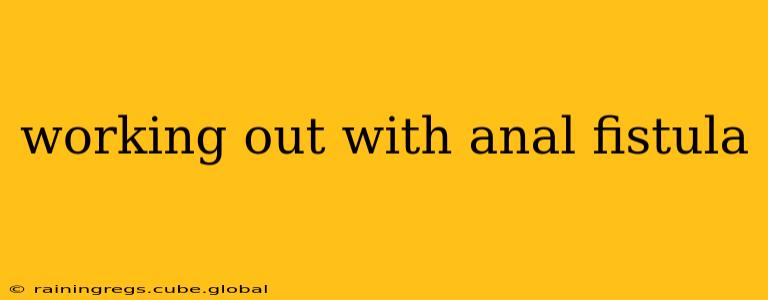Working Out with an Anal Fistula: A Guide to Safe and Effective Exercise
Living with an anal fistula can present challenges, and exercise might seem like the last thing on your mind. However, maintaining physical fitness is crucial for overall health and well-being, even with this condition. This guide explores how to safely and effectively work out while managing an anal fistula. Remember, this information is for general knowledge and shouldn't replace advice from your doctor or surgeon. Always consult your healthcare provider before starting any new exercise regimen.
What is an Anal Fistula?
An anal fistula is an abnormal connection between the anal canal and the skin near the anus. It's often caused by an infection of an anal gland, leading to a persistent, draining tract. Symptoms can include pain, swelling, drainage, and bleeding. The severity varies greatly, and treatment options depend on the individual case.
Can I Exercise with an Anal Fistula?
Yes, you can exercise with an anal fistula, but it's crucial to approach it carefully. The key is to listen to your body and avoid activities that could exacerbate your symptoms. Intense or high-impact activities might be problematic during the acute phase of the condition, or when you experience significant discomfort.
What Types of Exercise Are Safe?
Gentle exercises are generally best tolerated. These can include:
- Walking: A low-impact activity that promotes cardiovascular health without excessive strain. Start with shorter walks and gradually increase duration and intensity as tolerated.
- Swimming: The buoyancy of water supports your body, reducing stress on the affected area. This is a great option for cardiovascular fitness and muscle strengthening.
- Cycling (stationary or outdoor): Cycling can be beneficial, but ensure your bike seat is comfortable and adjust it appropriately to avoid pressure on the perineum.
- Yoga and Pilates: These focus on gentle stretches and strengthening exercises, promoting flexibility and core strength without undue strain. Avoid poses that put direct pressure on the affected area.
- Light strength training: Focus on upper body exercises to begin with, gradually incorporating lower body exercises as tolerated.
What Exercises Should I Avoid?
High-impact activities and exercises that put direct pressure on the perineum should be avoided, especially during the acute phase of the fistula or when you're experiencing significant symptoms. Examples include:
- Running: The repetitive jarring can irritate the fistula.
- Weightlifting (heavy): Straining during heavy lifting can worsen symptoms.
- High-intensity interval training (HIIT): The intense bursts of activity can be too much for the affected area.
- Contact sports: The risk of injury and trauma to the area is too high.
How Can I Modify My Workouts?
Adapt your workouts to your current condition. If you’re experiencing pain or discomfort, reduce the intensity and duration of your exercise. Listen to your body and rest when needed. Gradually increase the intensity and duration of your exercise as your symptoms improve.
Will Exercise Help My Fistula Heal?
Exercise itself won't cure an anal fistula, but maintaining a healthy weight and overall fitness can positively impact your general health and potentially aid in healing. A strong immune system is essential for combating infection, and regular exercise contributes to this. However, the primary treatment for an anal fistula is medical intervention guided by your healthcare professional.
When Should I See a Doctor?
You should consult your doctor if you experience increased pain, bleeding, or significant changes in your fistula drainage. They can assess your condition and provide appropriate guidance on exercise and other management strategies.
This information is for general knowledge and shouldn't replace advice from your doctor or surgeon. Always consult your healthcare provider before starting any new exercise regimen, especially when dealing with a medical condition like an anal fistula. Remember, prioritizing your comfort and carefully monitoring your body's response to exercise is key.
